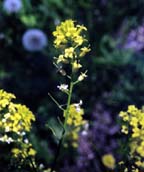12. Tiliaceae - Basswood, linden; mostly trees; leaves alternate; flowers in cymes, in Tilia with the peduncle adnate half its length to a large, membranous bract, which persists in fruit and aids in dispersal.
13. Malvaceae - Mallow, hibiscus, cotton; herbs or shrubs, often covered with stellate hairs; leaves alternate, simple, often palmately loved and veined, stipules present; flowers perfect, calyx of 3-5 sepals, ± united, sometimes subtended by coherent bracts (epicalyx); corolla of 5 separate petals; stamens numerous, monadelphous (filaments fused into a tube around the pistil); carpels 5 to many, united, ovary superior.
14. Sarraceniaceae - Pitcher plant; plants insectivorous, herbaceous perennials, leaves tubular or vaselike, usually filled with water and dead insects; flowers perfect, actinomorphic; style simple and forming an unbrellalike structure; fruit a capsule.
15. Drosseraceae - Sundew, venus flytrap; perennial, insectivorous, gladular herbs, often of acid bogs; leaves with sticky glands or sensitive hairs that trigger a folding mechanism; flowers perfect, sepals 5, united; petals 5, separate; stamens 5, carpels 2, 3, or 5, united.
16. Violaceae - Herbs (tropical members are trees and shrubs); flowers zygomorphic, 5-merous, petals 5, the anterior ones spurred, stamens 5, frequently 1 is spurred at the base.



17. Cucurbitaceae - Cucurbit, gourd; coarse, tendril-bearing vines; flowers usually yellow, imperfect; ovary inferior; fruit a berry or pepo.
18. Salicaceae - Willow, aspen, cottonwood; deciduous trees and shrubs; plants dioecious; catkin bearing; flowers seemingly subtended by bracts with a cup-like disc or gland; seeds with tufts of hairs.
19. Brassicaceae (Cruciferae) - Mustard; herbs with an odorous, watery juice; flowers of 4 sepals, 4 petals, and 6 stamens (4 long and 2 short); fruit a silique or silicle.


20. Ericaceae - Heath, rhododendron; woody, often shrubby; leaves alternate, evergreen or deciduous; flowers urceolate or campanulate; stamens distinct, often twice as many as the petals, anthers opening by terminal pores.


| TOP (Index Page) |
| Previous Subclass | Next Subclass |
| Magnoliidae | Hamamelidae | Caryophyllidae | Dilleniidae | Rosidae | Asteridae |
| Alismatidae | Arecidae | Commelinidae | Zingiberidae | Liliidae |